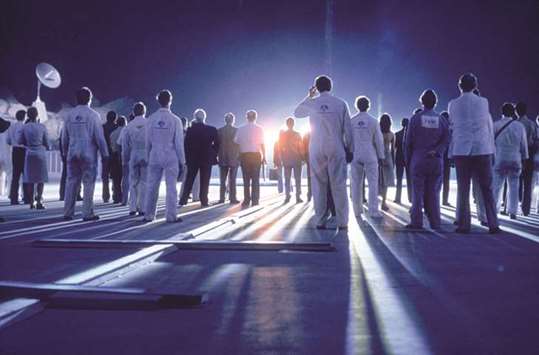A handful of great films have so little wrong with them, they’re like aliens to our world – pristine, triumphs of inevitability, magically right in terms of intent and technique and impact.
Most films that touch greatness, however, are different. They’re messy. You can find a hundred things not quite great about them, and even entire scenes that don’t come off, yet the filmmaker’s ideas and visual intuition become one, and the film’s limitations slide right off the greatness of it. However old or young you are when you first encounter those ideas and that intuition, things change in your moviegoing life.
That’s how it was for me at 16, when I first saw Steven Spielberg’s Close Encounters of the Third Kind. It came out in 1977, a few months after George Lucas’ Star Wars. I enjoyed Star Wars. It was against the law not to. I saw Star Wars four times that summer. Everyone did. It was designed for easy, carefree consumption and Atari-style revisitability. More quarters, another round.
Close Encounters was different. I wonder how first-time viewers in 2017 will respond to Spielberg’s supremely optimistic alien visitation narrative now that it’s back in US theatres for a week, in a 4K digital remastering financed by Sony Pictures. For kids and teens raised on Transformers movies (produced by Spielberg, among others, to his discredit), Close Encounters is like a new or very old filmic language.
The movie takes its time. The scenes of Indiana power company lineman Roy Neary (Richard Dreyfuss) falling apart, stricken and obsessed by inchoate visions of Wyoming’s Devils Tower National Monument, while his family wonders what the hell is wrong with him ... these are pretty wrenching. The 4K reissue interpolates a scene (a good one) from that domestic-frenzy section of the movie, cut from the original version but included in later editions, where Roy has locked himself in the bathroom and crouches in the shower, fully clothed. His wife Ronnie (Teri Garr, the late ‘70s era’s go-to for puzzled, distraught wives of neglectful husbands communing with higher powers) rescues him, temporarily. But one of the knocks against Spielberg’s script concerns how Roy happily skips out of his ordinary Midwestern life with wife and kids to join the human race’s select few in a rendezvous with extra-terrestrial destiny.
Spielberg himself acknowledges he’d never have written the Close Encounters script the way he did if he’d been a father then. Back in ‘77, and again this week, when I saw the film in full for the first time in decades, that part stuck in my craw. But the final 30 minutes of the movie, along with its first hour, remains a sublime and brilliantly imaginative experience, a blend of childlike wonder and technological wizardry. Douglas Trumbull’s optical effects (they tried a bit of proto-digital computer imagery, but it didn’t work) make Roy and the audience forget all about the family left behind. That’s how great that section of Close Encounters is: For better or worse, it turns you, the viewer, alongside Roy, into a preoccupied, vision-driven auteur, and you can forget about that noisy, mundane domestic life in Muncie.
The middle section of Close Encounters remains problematic. It takes a long time for Spielberg to establish Roy’s devolving old life, and the scenes of him wreaking havoc around the house, pulling plants out of the ground, throwing bricks through his kitchen window, remain slightly off, somewhat uncertain in comic tone. These scenes give way to the phony nerve-gas evacuation sequences out in Wyoming, designed to gin up the menace where there isn’t much.
What I love about Close Encounters has nothing to do with graceful plotting or complex depictions of a marriage at a breaking point. It has everything to do with visual scale. When the mothership comes ‘round the mountain, and composer John Williams’ five-note leitmotif becomes an intergalactic jam between humans and aliens, audiences in 1977 weren’t so much giddy and having a ball in the Star Wars vein. This was bigger, grander stuff, more mysterious and transporting. I cannot say what a 16-year-old me, in 2017, would think of the movie, or the serene happiness of its climax. In the movie’s wake, so many alien visitation scenarios in darker, more frightening moods have made the realm of the fantastic ... routine. (Terminator 2 recently came back to US theatres in a digital restoration, this time in 3-D. I’m glad the Close Encounters reissue isn’t in 3-D; visually, all the necessary dimensions were there to begin with.)
Nevertheless, Spielberg’s vision persists. It contains passages that are perfect: Roy’s first encounter, by the train tracks, is as good as popular moviemaking and spell-casting gets. Messy as it is, it means more to me than Star Wars ever did, and the 4K remastering wisely does not include that studio-ordered boondoogle of a “special edition” climax (circa 1980), where we see the inside of the mothership, and it’s nothing special. This 4K version looks terrific, but the movie still looks handmade, not machine-retooled. The various optical strategies – matte paintings, composites, models and miniatures galore, plus a bit of puppetry for a key alien in the finale – are everything young, happily abducted Barry (Cary Guffey) said they were: “Toys!” The best toys the movies could give us. -TNS

This 4K version looks terrific, but the movie still looks handmade, not machine-retooled.
